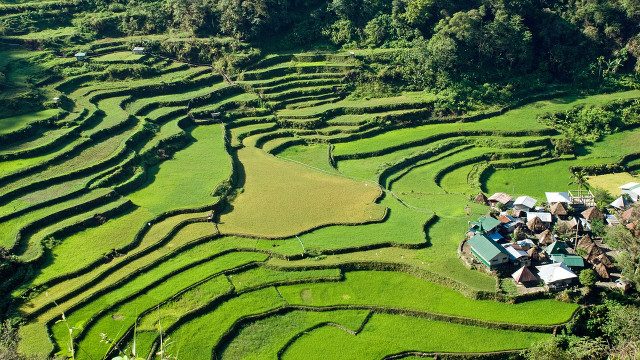SUMMARY
This is AI generated summarization, which may have errors. For context, always refer to the full article.

MANILA, Philippines – The Ifugao Rice Terraces may not be as ancient as our grade school history books would have us believe.
A team of scientists are set to present new findings that peg the age of the iconic rice terraces at 300 or 400 years instead of the long-assumed age of 2,000 years.
This means that, far from pre-dating Spanish colonization, the Ifugao Rice Terraces may be just as old as some colonial-period churches.
The earlier dates were arrived at based on radiocarbon-dating and paleoethnobotanical remains found in the rice terraces, said Stephen Acabado, director of the Ifugao Archaeological Project (IAP).
The IAP – composed of archaeologists from the University of the Philippines, National Museum and University of California, Los Angeles, and civil society group Save the Ifugao Terraces Movement – is set to present its 2012 to 2014 findings this June.
The rice terraces, declared a UNESCO World Heritage site in 1995, are widely-regarded as a relic of a time before European colonization. But IAP claims that, in fact, the rice terraces may have been a consequence of Spanish colonization in more low-lying communities.
“The current dataset indicates that wet rice was cultivated later, after 1650, soon after the appearance of the Spanish in the Magat Valley in the late 1500s,” Acabado told Rappler in an email.
Before 1650, the Cordillerans had smaller terraces planted with taro, a root crop. Even then, these small terraces had been irrigated.
But once Spaniards began colonizing lowland communities in the 1500s, groups from these communities began escaping to the Cordilleras.
The new arrivals, the lowlanders, were much more accustomed to rice as a food staple. The bloated population in the highlands also now required more food. The small taro terraces were thus converted to rice terraces.
Growing populations caused the rice terraces to grow larger and larger, into the world-famous Ifugao Rice Terraces we see today.
Textbook theory refuted
IAP’s findings refute the popular theory of Henry Otley Beyer and Roy F. Barton – the theory you would find in most Philippine history text books.
The two pioneer anthropologists were the first to peg the age of the rice terraces at 2,000 years.
“The 2,000-year dating of Beyer and Barton were not based on any archaeological or scientific evidence. They came up with their estimate by speculating how long it would have taken the Ifugao to construct the terraces. It was also a product of the prevailing model of population and technological movement of their time,” said Acabado.
Their theory had assumed that Cordillerans had minimal contact with lowland peoples and that Spanish colonization had no significant impact on Cordilleran culture and the development of the rice terraces.
IAP’s findings are backed up by radiocarbon-dating and other studies of samples from 4 rice terrace sites: Bocos in Banaue, Habian (Old Kiyyangan), Kiangan, and Hapao, Hungduan.
In these sites, the archaeologists found no remains of wet rice on the paddies but found ample evidence of taro.
However, the sites do not cover all the clusters of the Ifugao Rice Terraces.
Instead, Acabado said the sites were chosen based on “careful ecological and environmental modeling” making them “representative of all the systems.”
For instance, Kiangan, known as the site of the oldest Ifugao village, was included in the study. The village, according to findings, had also subsisted on taro.
Academic publications supporting IAP’s findings have been peer-reviewed by scientists and professional archaeologists.
World Heritage status
Does the new-found youth of the Ifugao Rice Terraces change anything?
Acabado addressed worries that the new dating of the rice terraces would diminish its importance as a world historical treasure.
In fact, the discovery affirms the technological and cultural sophistication of the people who built such majestic terrace systems in so short a time, he said.
“This sophistication allowed the Ifugao to rapidly modify their landscape to fill valley after valley with terraced rice fields within 200 years,” said Acabado.
The team’s findings shed new light on the mysterious terraces and increase understanding of the dynamic between highland and lowland communities at the beginning of Spanish colonization.
“It is more important for us that we acknowledge that we are in danger of losing these historical and cultural monuments and that we, as a nation, have a responsibility to take part in preserving our heritage,” added Acabado.
Groups have been working hard to preserve the Ifugao Rice Terraces, still a source of livelihood for Cordillera farmers and a valuable tourist attraction. (READ: Save the Ifugao rice terraces? Scholarships are key)
But natural disasters, migration of Cordillerans to cities, and modernization have left the rice terraces damaged or abandoned. (READ: Ifugao hydropower plant to help save rice terraces)
In 2001, the United Nations put the rice terraces in its list of endangered World Heritage sites. Efforts of the community, government, and private sector led to its removal from the list in 2012. – Rappler.com
Cordillera rice terraces image from Shutterstock
Add a comment
How does this make you feel?
There are no comments yet. Add your comment to start the conversation.